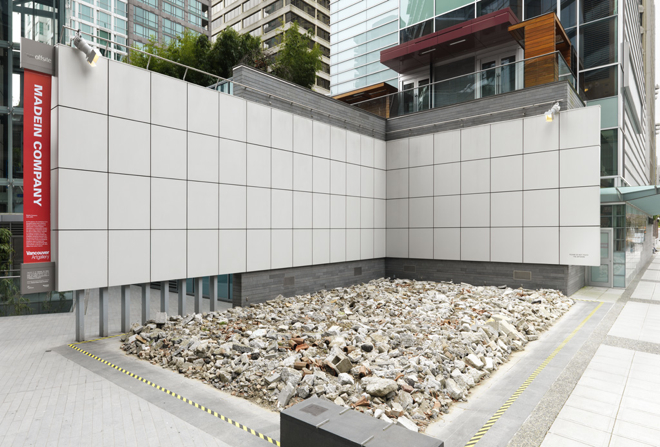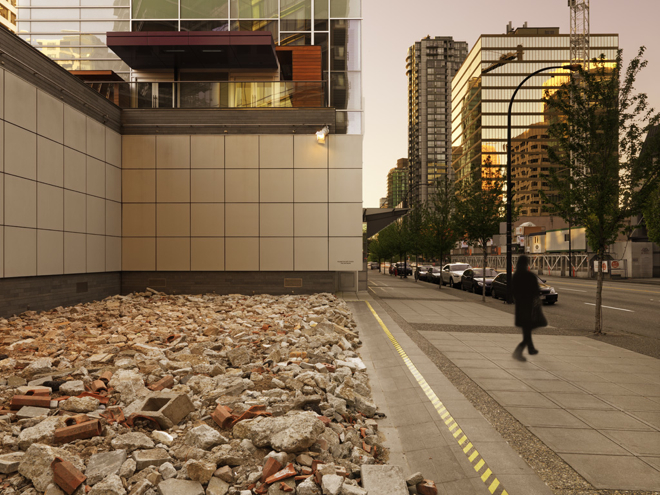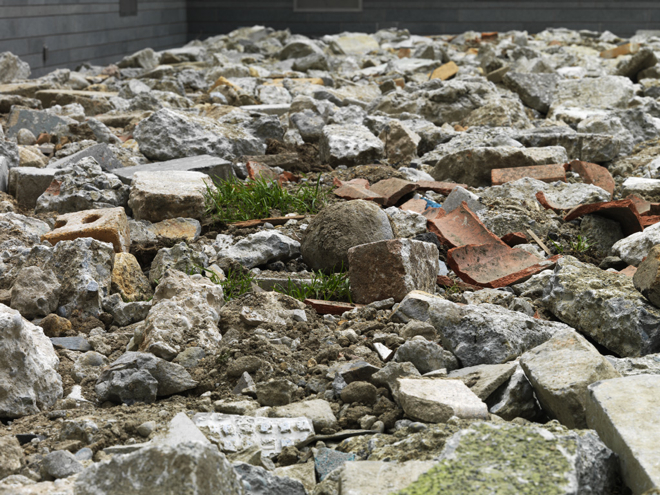“Calm” by MadeIn Company
Offsite (1100 West Georgia Street, Vancouver, located on West Georgia Street between Thurlow and Bute Streets, west of the Shangri-La Hotel) Apr 26–Sep 29, 2013
A low, flat jumble of dusty wreckage sits one meter or so above the surrounding downtown sidewalk, but its sides descend to an oddly contrasting edge, a trim rectangle fifteen by eight meters. MadeIN Company’s “Calm” is public art at its best—big and familiar, yet challenging, subtle and brash. Love it or hate it, it provokes a response from everyone.
The work is currently on show at Offsite, a permanent outdoor public exhibition space in downtown Vancouver, Canada, which hosts newly commissioned works of public art for six-month stints. Uniquely collaborative, the shows are curated by the Vancouver Art Gallery and funded by the City of Vancouver in partnership with the Shangri-La Hotel.

Surrounded by high-end comfort, wealth and glamour, this installation of broken concrete, chipped tiles, smashed pipes, discarded bricks and twisted rebar carries a disjointed allure—that of a broken world as well as a strange apparition. The whole surface rolls very slowly, like motorized flotsam and jetsam or hypnotic slow-motion aftershocks. The effect is mesmerizing.
“Calm” fits into the collective’s oeuvre, which includes many works that incessantly attempt to toy with our visual and cognitive perceptions. Just when the viewer is losing interest, something usually moves, breathes, zings, flies, sucks — see Xu Zhen’s “The Last Few Mosquitos” (2005) or “Action of Consciousness” (2011) — and, suddenly, there is a reason to stick around and wrestle with a new absurd tangent.
Diana Freundl, the curator, says, “The work is about perception; when you first look at it you think it’s a pile of rubble but then when you view it for a few seconds you start to notice that it undulates and you start to unearth other meanings….”
Let us ponder that in a minute. First let’s deal with a nagging distraction: materials and mechanics. The rubble was sourced in Vancouver from a Jewish synagogue, which was renovated (not demolished) earlier this year. And the parts that make it move (two industrial-sized waterbeds and a motor) were shipped here from Shanghai.
Willing and patient viewers have much to consider—no doubt influenced by the setting. The Shangri-La Hotel, along with high-rise apartments and corporate headquarters, tower over “Calm,” as do cranes and construction sites. It sits adjacent to Georgia Street, a busy downtown thoroughfare where people walk and drive by on their way to work, to shop, to tour. Many people stop to gaze and gawk.

And talk. Every time I visit the site, I have unprovoked conversations with strangers. Once, I watched two men having a loud argument about whether “Calm” was art. When one man stormed off, the straggler, needing to talk, said to me, “He doesn’t get it but I do. It is about Vancouver and all the construction everywhere.”
Far away from the daily occurrences of destruction and calamity, Vancouver provides a suitable blank canvas and allows for broad yet rich interpretations of the artwork, as well as personal responses and reflections. All of which are important components of successful public art. Whether it implies that new developments emerge from chaos or maybe suggests impending destruction, “Calm” gives the viewer something to consider.
In 2009, a similar but much smaller version of “Calm” was developed for “Seeing One’s Own Eyes,” an exhibition by MadeIn about Middle Eastern Contemporary Art exhibited in Shanghai and Europe. This time round, set in a very young New World city, geographical clichés are avoided. And as a solitary work in a public setting, the large-scale installation beckons an array of people.
And as with any street level art, the usual “hands off” rule is proving to be a tricky thing to monitor. A video of thrill-seekers walking on its moveable surface went viral on Youtube — triggering off a number of copycats. Extra signage, as well as security, is in place for upcoming civic celebrations when crowds of people will fill Vancouver’s downtown streets. Yet, these naive and unwanted interactions continue to persist, threatening not only the longevity of the work but raising the problem of personal injury lawsuits.
Whether they appreciate it as art or not, plenty of people have viewed “Calm.” Stories about it have circulated in the local media. News reports have discussed the origins of the debris. Some people report being intrigued, some skeptical. Others are emotionally moved.. Some openly hate it. Other viewers just want to understand how “Calm” works. MadeIn’s reputation for humor, provocation and cynicism leaves room for all of these public responses.

For decades artists have explored the movement of earth and rubble and the public has looked on in fascination (and outrage) at its simplicity. In the 60s, Michael Heizer’s earthworks displaced tons of dirt on a massive scale. Since 1977, visitors have viewed Walter de Maria’s “New York Earth Room.” More recently, Urs Fischer removed Gavin Brown’s gallery floor and replaced it with a trench of dirt and bits of rubble.
“Calm’s” inclusion of rubble — materials that once offered shelter and protection — prompts comparisons to Robert Smithson’s “Partially Buried Woodshed” or Gordon Matta-Clark’s augmentation of decaying and dilapidated buildings. In these works, there is evidence of human life, stories, memory and emotion. “Calm’s” animated mechanisms also suggest that there was once more than meets the eye. And in this case, there still is.
Jennifer Hall is a writer, researcher and educator based in Vancouver.